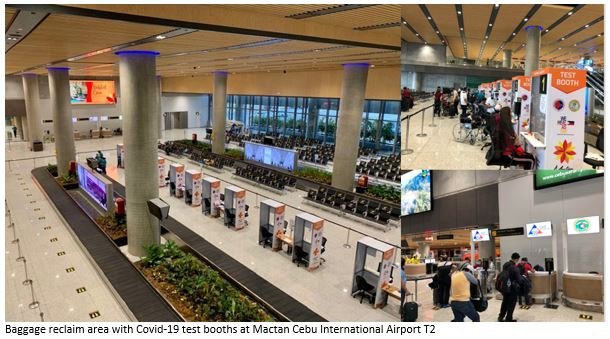Mactan-Cebu International Airport ready to restart operations with enhanced safety measures

Mactan-Cebu International Airport Authority (MCIAA) and GMR MEGAWIDE Cebu Airport Corporation (GMCAC) is ready to resume operations with safety measures already in place at both Terminals 1 and 2. This is in preparation for the expected ease of travel restrictions and the resumption of airline flight services.
According to GMCAC Chief Executive Advisor Andrew Acquaah-Harrison, the operating procedures and overall airport environment of MCIA have been modified for the “new normal”, while staff have been re-trained in its implementation in adherence with the guidelines of the Inter-Agency Task Force for the Management of Emerging Infectious Diseases (IATF-EID), the Department of Health (DOH), and the Department of Transportation (DOTr).
“As we experience a new norm in traveling, we will keenly observe how the passengers will react to the new environment and make adjustments when necessary. At the same time, we ask the passengers and staff for their cooperation and understanding as we implement these new measures for their well-being and safety,” said Harrison.
Health and safety measures for passengers and airport staff
Passengers and airport staff are directed to strictly observe these measures while inside MCIA:
- Strictly adhere to social distancing protocols and follow the visual markers placed in different locations. Always stay in the right lane when walking.
- Wear face masks and other PPEs within the airport vicinity and inside the terminals.
- Comply with body temperature checks conducted by the security personnel at all airport entry points.
- Regularly sanitize their hands and disinfect shoes using provided hand sanitizers and footbaths placed at common passenger areas.
- Limit send-off parties at the departure area to one companion only regardless of the number of passengers traveling together.
- Be honest and provide correct information when filling out health declaration forms.
- Read COVID-19 health information materials posted in strategic locations of the terminal.
- Listen to PA announcements for health and safety reminders.
MCIA builds a COVID-19 testing laboratory
MCIAA and GMCAC also announced that MCIA will be the first airport in the country to be equipped with a dedicated COVID-19 testing laboratory with state-of-the-art facilities that can process about 900-1,500 swab samples per day from arriving Overseas Filipino Workers (OFWs), seafarers, and locally-stranded individuals. The use of the laboratory will eventually be extended to outbound international passengers requiring a COVID-19 test certificate for entry to other countries.
Testing booths are located in an isolated area in T2 Arrival Reclaim. Swab sampling takes a maximum of 5 minutes, after which OFWs and seafarers are transferred to designated quarantine facilities by the Overseas Workers Welfare Administration (OWWA) and the Department of Tourism (DOT) while waiting for their test results. Test results will be available online after 24-hours.
“This initiative will augment the government’s testing capacity and fast track the processing of arriving OFWs and seafarers and decongest Manila. It will help alleviate the plight of OFWs and seafarers who desperately want to return to Central and Southern Philippines but are stranded in quarantine centers in Manila while waiting for their COVID test results,” said MCIAA General Manager Steve Dicdican.
Once swab samples are taken, OFWs and seafarers will be billeted in hotels designated as quarantine facilities by the Overseas Workers Welfare Administration (OWWA) and the Department of Tourism (DOT) while waiting for their test results.
“We believe this measure will give an important capacity boost to DOH, help safeguard jobs in hotels and related sectors in the immediate term, but most importantly pave the way for international arrivals to resume as the confidence to travel to Cebu from the tourists and foreigners starts to build,” said Harrison.
The laboratory operator Prime Care is accredited and certified by the DOH and the Research Institute for Tropical Medicine (RITM).


